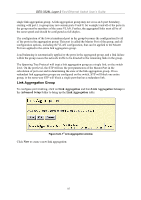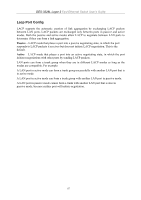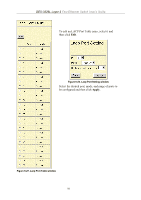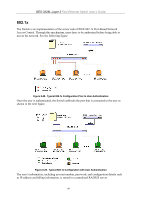D-Link DES-3226L User Manual - Page 97
Link Aggregation Group, Advanced Setup
 |
UPC - 790069262722
View all D-Link DES-3226L manuals
Add to My Manuals
Save this manual to your list of manuals |
Page 97 highlights
DES-3226L Layer 2 Fast Ethernet Switch User's Guide single link aggregation group. A link aggregation group may not cross an 8-port boundary, starting with port 1 (a group may not contain ports 8 and 9, for example) and all of the ports in the group must be members of the same VLAN. Further, the aggregated links must all be of the same speed and should be configured as full duplex. The configuration of the lowest numbered port in the group becomes the configuration for all of the ports in the aggregation group. This port is called the Master Port of the group, and all configuration options, including the VLAN configuration, that can be applied to the Master Port are applied to the entire link aggregation group. Load balancing is automatically applied to the ports in the aggregated group, and a link failure within the group causes the network traffic to be directed to the remaining links in the group. The Spanning Tree Protocol will treat a link aggregation group as a single link, on the switch level. On the port level, the STP will use the port parameters of the Master Port in the calculation of port cost and in determining the state of the link aggregation group. If two redundant link aggregation groups are configured on the switch, STP will block one entire group, in the same way STP will block a single port that has a redundant link. Link Aggregation Group To configure port trunking, click on Link Aggregation and then Link Aggregation Group in the Advanced Setup folder to bring up the Link Aggregation table: Figure 6-24. 1st Link Aggregation window Click New to create a new link aggregation: 85















